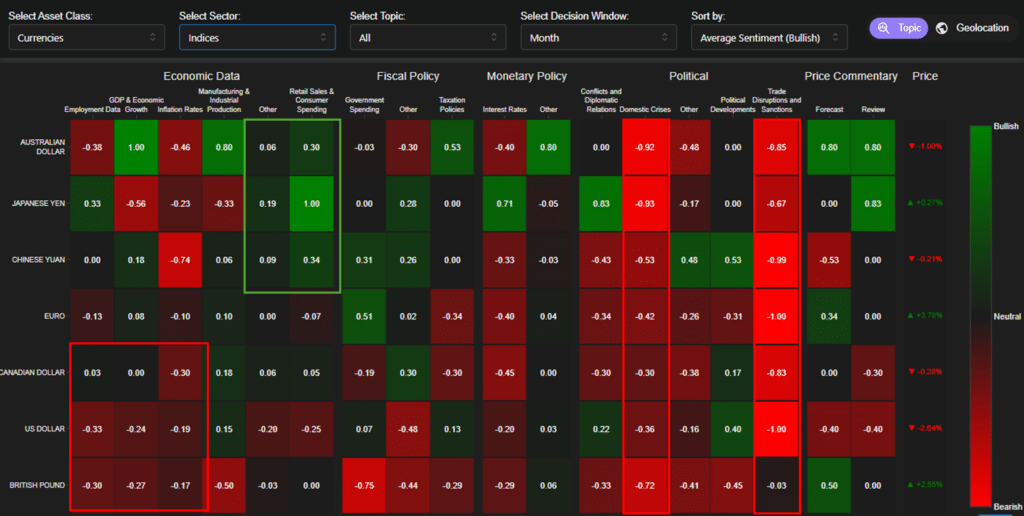*This article analyses how trade tensions are affecting different economies, highlighting UK’s resilience, Asia-Pacific’s retail growth, and Western nations’ employment challenges. It’s aimed at institutional investors and financial professionals seeking data-driven insights on currency markets and macroeconomic trends to inform their investment strategies in an increasingly complex global trade environment.
In the constantly evolving theatre of global finance, understanding the increasingly intricate relationships between trade policies, domestic economic indicators, and currency movements has never been more fundamentally important that during the times we are living through. Despite what Trump purports, we – like many others – maintain there is nothing “beautiful” about tariffs. In this article, we’ll look at the latest global trade tariff impact through our Trading Co-Pilot’s newly launched Sector Analysis feature, which reveal a fascinating divergence in how major economies are responding to mounting global trade tariff pressures.

The widening impact of global trade tariff tensions
When looking at our LLM-driven market sentiment data across G10 currencies using our new Sector Analysis feature, a clear pattern emerges: nearly all major economies are displaying signals of domestic crisis against the backdrop of escalating global trade tariff conflicts. This week’s imposition of tariffs by the Trump administration has only exacerbated these tensions. Perhaps one of the most interesting stories here – particularly for those of us based out of the UK is that the United Kingdom stands as a notable exception to this trend.
Our Sector Analysis sentiment matrix provides a detailed breakdown of how these tensions are manifesting across different economic dimensions. The data suggests that the ripple effects of trade barriers are now extending beyond immediate trade balances and beginning to influence core domestic indicators.
As we can observe from our sentiment heatmap, the negative values clustering around employment data and inflation rates for most currencies tell a worrying story about market concerns. What we are clearly seeing is that in terms of market sentiment, the global trade tariff impact is no longer contained to international commerce metrics but has created vulnerabilities throughout domestic economic structures. The imposition of these taxes will, presumably, only deepen these vulnerabilities.
Asia-Pacific resilience: Retail strength amid global uncertainty
On the bright side, a more positive insight from our analysis is the resilience currently being displayed in retail and consumer sectors across several Asia-Pacific economies. The Australian Dollar, Japanese Yen, and Chinese Yuan are all showing strong positive sentiment values in retail sales and consumer spending categories.
In particular, the Australian Dollar exhibits a robust +0.80 sentiment score particularly in connection with manufacturing and industrial production, complemented by an impressive +1.00 in GDP growth indicators. Similarly, the Japanese Yen demonstrates robust strength in consumer spending with a +1.00 sentiment reading, suggesting that domestic consumption remains buoyant despite external pressures.
What makes this particularly noteworthy is that this retail strength persists despite the global trade tariff impact threatening supply chains and potentially increasing consumer prices. Our Trading Co-Pilot’s cross-dimensional analysis indicates that these economies have successfully insulated their consumer sectors through a combination of monetary policy adjustments and fiscal support measures.
Western Economies: Employment concerns and inflation anxiety
Moving on, in stark contrast to the Asia-Pacific region’s consumer resilience, Western economies are displaying troubling signals in employment data and persistent inflation concerns. The sentiment readings for the Canadian Dollar, US Dollar, and British Pound reveal a consistent pattern of weakness in labour market indicators.
The Canadian Dollar’s -0.30 sentiment in inflation rates, coupled with the US Dollar‘s -0.33 reading in employment data, points to a challenging economic environment where central banks face the difficult balancing act of addressing inflation without triggering further employment deterioration. What makes this all the more worrying is the rhetoric surrounding these policy decisions, with bizarre arguments such as tariffs being “job creators” flying in the face of the data our Trading Co-Pilot is surfacing.
Most telling is the cluster of negative sentiment values in the Western currencies’ GDP growth prospects. These values suggest that the global trade tariff impact is creating more profound structural challenges for these economies than for their Asia-Pacific counterparts.
Our analysis also reveals that markets anticipate these employment and growth challenges to persist, with forecasting models indicating continued pressure. This is particularly evident in the deeply negative readings in the trade disruptions category, where Western currencies universally display sentiment scores below -0.8.
UK’s mixed signals
Now here’s an interesting story – while the UK shares some of the employment and GDP concerns of its Western counterparts, our Sector Analysis breakdown reveals a more nuanced picture. Here, we can see the British Pound showing stronger resilience in market sentiment in certain categories, particularly in monetary policy sentiment, where it outperforms both the US and Canadian dollars.
This relative strength may explain why the UK appears to be weathering the global trade tariff impact more effectively than other major economies (for now, at least). The data suggests that market sentiment perceives UK monetary policy as more appropriately calibrated to current economic conditions, despite the challenges in growth and employment.
Furthermore, the UK’s +0.50 reading in the forecast category stands in contrast to the negative readings for both the US and Canadian dollars, indicating greater market confidence in the UK’s medium-term economic trajectory.
As the above trends continue to evolve, our LLM-driven Sector Analysis feature is a powerful way of monitoring shifts in sentiment across all categories in real-time. The retrograde step in global trade policy will continue to require careful analysis as its effects ripple through economies worldwide. Ultimately, the persistence of these patterns, particularly the strength in Asia-Pacific retail sectors and the weakness in Western employment data will be key indicators of how the global trade tariff impact will continue to reshape the economic landscape.
Conclusion
The current global economic environment presents a complex picture of vulnerabilities and resilience. While the global trade tariff impact continues to create headwinds for most major economies, the divergent responses across different regions offer valuable insights for investors and policymakers alike.
By leveraging our Trading Co-Pilot’s comprehensive sentiment analysis, market participants can gain a deeper understanding of how these cross-currents are likely to influence currency movements and economic outcomes in the months ahead. As always, we remain committed to providing timely, data-driven insights that cut through market noise and highlight the trends that truly matter.
Enhance your market intelligence
Ready to move beyond surface-level market analysis? Our Trading Co-Pilot delivers comprehensive macroeconomic sentiment data you need to navigate today’s complex investment environment with confidence. Our proprietary LLM-driven analytics tool provide institutional investors with unparalleled insights into global economic trends, helping you identify emerging opportunities and avoid hidden risks before they impact your portfolio. To request a personalised demo of our Trading Co-Pilot dashboard and to learn how you can leverage our analytics for your investment and trading decisions, simply contact our team at enquiries@permutable.ai or fill in the form below to request a complimentary trial.
